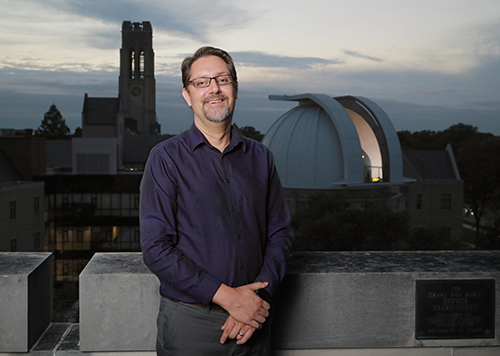How do you define a year?
It’s a good question to ask today, Feb. 29, a leap day that traces its origins to the astronomically accurate definition of a year. Most people would define a year as the amount of time needed for the Earth to complete one orbit around the sun, and that’s mostly right. But because precision matters in science, we define the astronomical or “tropical” year as the length of time it takes the sun to return to a particular spot in the sky called the vernal equinox.

Dr. Michael Cushing is a professor in the Department of Physics and Astronomy and director of the Ritter Planetarium.
That makes the tropical year 365.24219402 days, or 365 days, 5 hours, 58 minutes and 45.6 seconds.
You can immediately see a problem if you are trying to create a calendar: The year isn’t a round number of days.
Julius Caesar came up with a solution when he created a calendar that was 365 days, but every fourth year another day was added to make it 366 days — a leap day. This way the average year was 365.25 days, which is pretty darn close to 365.24219402 days.
Problem solved, right? Well, no.
The difference is only 11 minutes and 14 seconds, but those 11 minutes and 14 seconds add up. After 1,200 or so years, they meant that the vernal equinox was occurring on March 11, and not near March 21 like it did under Caesar.
In 1582 Pope Gregory instituted the Gregorian calendar to ensure that Easter was celebrated at roughly the same time of year that it was celebrated when it was introduced by the Catholic Church. Gregory eliminated 10 days from the Julian calendar, and he also removed a leap day once every 100 years. This meant that the average length of the year became 365.240 days – an overcorrection that put the average length of the year shorter than the tropical year. So, Gregory then added a leap day back in every 400 years, putting the average length of the year at 365.2425 days, which is equal to the tropical year to within 27 seconds.
This is the calendar that we use today.
Not everyone adopted this calendar immediately. Britain, and thus the American colonies, didn’t do so until 1752, as Ben Franklin described in Poor Richard’s Almanack.
Franklin would later reflect on how the new calendar affected him: On the Julian calendar he was born on Jan. 6, 1706, but in the Gregorian calendar he was born on Jan. 17, 1706. “I feel still some Regard for this Sixth of January, as my old nominal Birth-day … ” he wrote to his wife in 1773.
Dr. Michael Cushing is a professor in the Department of Physics and Astronomy and director of the Ritter Planetarium.